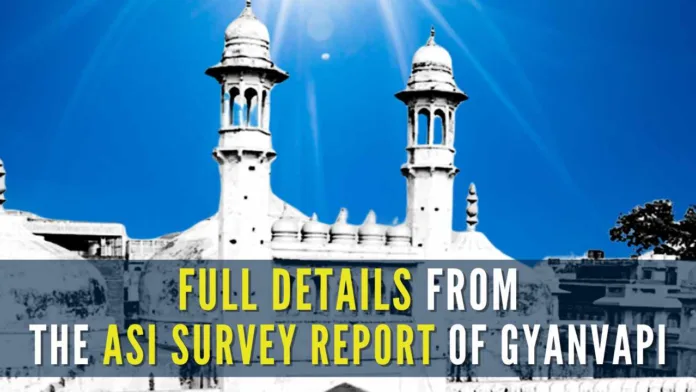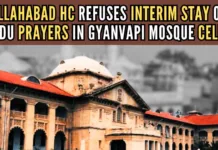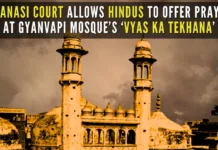
Major findings by ASI survey at Gyanvapi mosque complex
PGurus is publishing below the major findings of the Archaeological Survey of India (ASI), tasked by the Varanasi district court in July 2023 to conduct a scientific survey of the Gyanvapi mosque complex. The report (given to all parties of the case) has concluded that “there existed a Hindu Temple prior to the construction of the existing structure”. Here are the major findings published below:
The ASI report said: “Based on scientific studies/ survey carried out, the study of architectural remains, exposed features, and artefacts, inscriptions, art, and sculptures, it can be said that there existed a Hindu Temple prior to the construction of the existing structure.”
“The Arabic-Persian inscription found inside a room mentions that the mosque was built in the 20th regnal year of Aurangzeb (1667-77). Hence, the pre-existing structure appears to have been destroyed in the 17th century, during the reign of Aurangzeb, and part of it was modified and reused in the existing structure.”
“Existing architectural remains, decorated mouldings, on the walls, karna-ratha and prati-ratha of the central chamber, a large decorated entrance gate, with Torana on the eastern wall of the western chamber, a small entrance with the mutilated image of lalatabimba, birds and animals carved for decoration in and outside suggest that the western wall is remaining part of a Hindu Temple. Based on art and architecture, this pre-existing structure can be identified as a Hindu Temple.”
“Sculptures of Hindu deities and carved architectural members were found buried under the dumped soil in cellar S2.” The report stated that “pillars from earlier temples were reused while making cellars in the eastern part of the platform”.
“A pillar decorated with bells, niches for keeping lamps on all four sides, and bearing an inscription of Samvat 1669 (corresponding to 1613 CE, January 1, Friday) is reused in cellar N2,” said the ASI Report given to all litigants on Thursday.
“A series of cellars were also constructed to the east to create additional space and a large platform in front of the mosque for accommodating a large number of people for prayers.”
“ASI had in its custody record of an inscription engraved on a loose stone which recorded the construction of the mosque in the 20th regnal year of Hadrat Alamgir i.e. Mughal Emperor Aurangzeb corresponding to A.H. 1087 (1676-77 CE). The inscription also recorded that in the year A.H. 1207 (1792-93 CE), the mosque was repaired with sahan, etc. The photograph of this stone inscription was recorded in ASI records in the year 1965-66.”
“During the recent survey, this stone with inscription was recovered from a room in the mosque. However, the lines relating to the construction of the mosque and its expansion have been scratched out.”
“This is also brought out by the biography of Emperor Aurangzeb, Maasir-i-Alamgiri, which mentions that Aurangzeb ‘issued orders to the governors of all provinces to demolish the schools and temples of the infidels’ (Jadunath Sarkar tr 1947, Maasir-i-Alamgiri, pp 51-52). On September 2, 1669; it was reported that, according to the Emperor’s command his officers had demolished the temple of Vishwanath at Kashi’ (Jadunath Sarkar (tr.) 1947 Maasir-i-Alamgiri p.55).”
“During the survey, several inscriptions were noticed on the existing and pre-existing structures. A total of 34 inscriptions were recorded during the present survey and 32 estampages were taken”.
“These are, in fact, inscriptions on the stones of the pre-existing Hindu Temples, which have been reused during the construction/ repair of the existing structure. They include inscriptions in Devanagari, Grantha, Telugu, and Kannada scripts. Reuse of earlier inscriptions in the structure, suggest that the earlier structures were destroyed and their parts were reused in construction/ repair of the existing structure”.
“Three names of deities such as Janärdhana, Rudra, and Umesvara are found in these inscriptions. Terms such as Maha-muktimandapa mentioned in three inscriptions are of great significance”. Under the headline “Pillars and Pilasters”, the ASI report stated, “The pillars and pilasters used in the existing structure were studied systematically and scientifically. For the enlargement of the mosque and constructing sahan, parts of the pre-existing temple including pillars and pilasters were reused with little modifications. Minute studies of the pillars and pilasters in the corridor suggest that they were originally part of the pre-existing Hindu Temple. For their reuse, in the existing structure, Vyala figures carved on either side of lotus medallion were mutilated and after removing the stone mass from the corners that space was decorated with floral design. This observation is supported by two similar pilasters still existing on the northern and southern wall of the western chamber in their original place.”
“This temple had a big central chamber and at least one chamber to the north, south, east, and west respectively. Remains of three chambers to the north, south, and west still exist but the remains of the chamber to the east and any further extension of it could not be ascertained physically, as the area is covered under a platform with stone flooring”.
“The central chamber of the pre-existing structure forms the central hall of the existing structure. This structure with thick and strong walls, along with all architectural components and floral decorations was utilized as the main hall of the mosque. Animal figures carved at the lower ends of decorated arches of the pre-existing structure were mutilated, and the inner part of the dome is decorated with geometric designs”.
“The entrance to the central chamber of the temple was from the west which was blocked by stone masonry. This entrance was decorated with carvings of animals and birds and an ornamental torana. This large arched gateway had another smaller entrance. The figure carved on the lalatbimba of this small entrance has been chopped off. A small part of it is visible as most of it is covered with bricks, stone, and mortar which were used to block the entrance”.
The ASI report pointed out that “remains of a bird figure carved on the doorsill appears to be of a cock”, adding that “on the other side of the blocked main entrance quibla was made. It is simple without any decoration as such and unevenly. plasters on either side are also damaged unevenly”.
“Eastern half of the western chamber still exists whereas the superstructure of the western half has been destroyed. This chamber was also connected with the north and south chambers through a corridor accessible from its north and south entrances respectively. Remains of this corridor in the northwest side came to light on the removal of garbage and debris”.
“The western wall of the existing structure is the remaining part of a pre-existing Hindu temple. This wall, made of stones and decorated with horizontal mouldings, is formed by the remaining parts of the western chamber, western projections of the central chamber, and western walls of the two chambers on its north and south. Central chamber attached to the wall still exists unchanged whereas modifications have been made to both the side chambers”.
The ASI said that “all these chambers had an opening in all the four directions. Decorated arched entrances of the central, north, and south chambers towards the west have been blocked. The arched openings of the north and south halls were converted into steps leading to the roof. Steps made in the arched entrance of the north hall are still in use. Steps made in the arched entrance of the south hall were blocked by stone masonry at some later date however one can still enter them from the roof. A large decorated entrance to the central chamber through the western chamber was blocked by stone masonry”.
“Hence, the pre-existing structure appears to have been destroyed in the 17th century, during the reign of Aurangzeb, and part of it was modified and reused in the existing structure. Based on scientific studies/surveys carried out, the study of architectural remains, exposed features, and artefacts, inscriptions, art, and sculptures, it can be said that there existed a Hindu Temple prior to the construction of the existing structure,” concluded the ASI Report clearly showing that Aurangzeb destroyed Hindu Temple and built Gyanvapi Mosque.
For all the latest updates, download PGurus App.
- Supreme Court rejects plea to tally all VVPAT slips with EVM votes; says ‘no going back to paper ballot’ - April 26, 2024
- US report citing human rights violations is deeply biased: India - April 25, 2024
- Kotak Mahindra Bank shares tank 13%. Market Cap erodes by Rs.37,721 cr post-RBI action - April 25, 2024











I am reminded of the movie, Finding Nemo, where all the remaining fish from the fish tank somehow make their way into the ocean inside plastic bags, and then are like “now what?”.
I am not saying Hindus are in the same boat, but we have to weigh our options carefully. Our position should be clear -acknowlege the real history at a minimum, if an apology seems to be a lot. Do not desecrate our holy symbols and idols – speciially where you have a current structure belonging to one of the abrahamic faiths there. This is the bare minimum.
Our fight against leftist ideologies, false narratives must continue. Our fight for our right to govern our religious places of workship, and to start religion based educational institutions must continue. Our fight to correct the historical records and what is taught in schools must continue. Our fight against conversion, forced occupation, demographical changes, surrounding temples and military locations with their ghettos and shops, must all continue.
But, are what is our position with regards to Kashi-Viswanath, Mathura etc? We have our Ram-Lalla in Ayodhya. This may have sufficed if the other side willingly acknowleged the past. What is the next step?
Let us not address these invaders, looters , destroyers of the Hindu Temples as ” EMPERORS”.
It is shame on our part to call them as emperors. Let us destroy the Leftists fabricated history. Let us not leave these leftists fabricators of histroy caught free. They have to pay for their misdeeds. their motive was to make us inferior, timid. Time has come for us to be on offence especially with leftists.